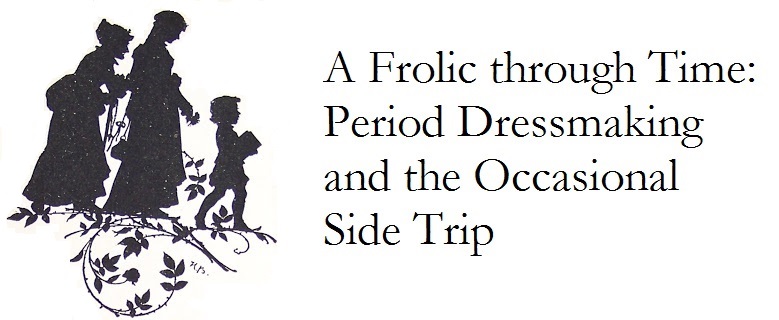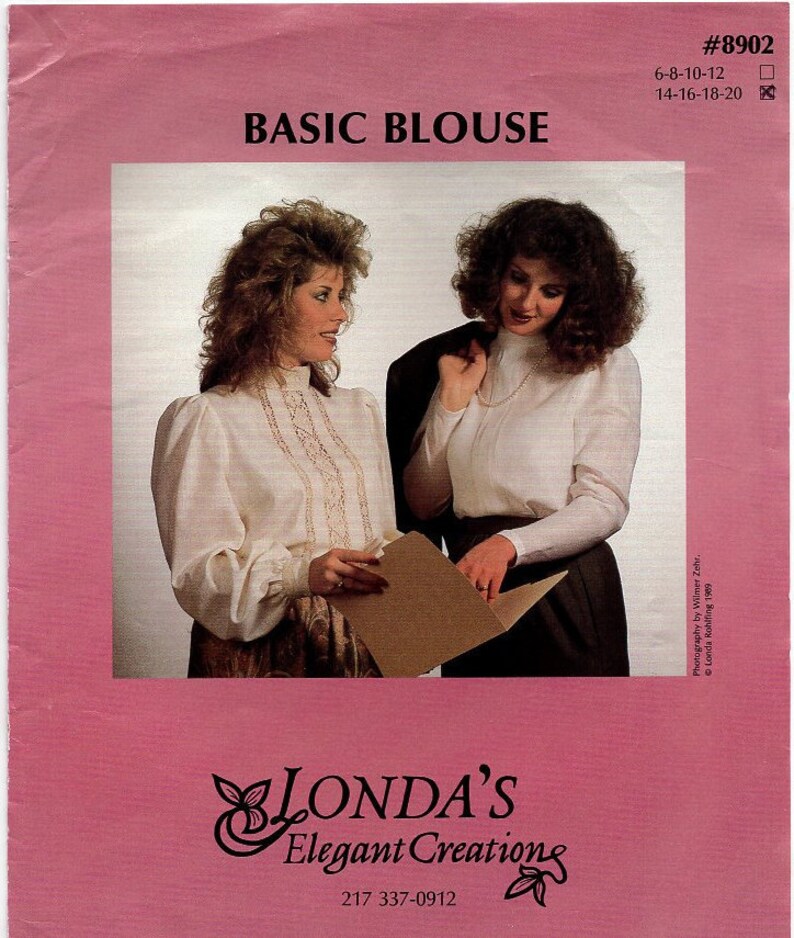 |
| You can clearly see how full the right sleeve with the plumper inside it is, while the left sleeve is deflated. Oh, and the hair! Yes, those are natural curls. I've let it do its thing for the nonce. |
Here's a first view of a wire sleeve plumper I made, set within the 1895 shirtwaist. It works a treat. It's just a prototype. Next I am going to try a version made with stash zip ties. The lighter version will win and I will make the second plumper to match.
I found the design for the prototype on the Augusta Auctions, as part of a previous lot of bustles and crinolines. It's a nice design, using a relatively small amount of wire and plumping both the top and the side of the sleeve at once. It was straightforward to copy, as you will see further on in this post.
First, however, let's talk about another option for sleeve plumping that I didn't take.
The Ladies Home Journal and puffed sleeves
I've been reading a number of 1890s magazines lately. You already know about Illustrierte Frauenzeitung, and of course there's Harper's Bazar, but the one I've found most useful for comparing changes in both fashion and clothing construction over the 1890s is Ladies Home Journal. It's a real treat of a magazine. Including in its target subscribers women of moderate income, the journal offered fiction by well-known American writers of the day, such as Frank R. Stockton (anyone remember the phrase "the lady or the tiger"? It's from a story of his), and articles by luminaries such as William Dean Howells. If you recall reading The Rise of Silas Lapham in high school or college, that's the author.
Ladies Home Journal subjects covered included fashion -- including what to wear to a desk job -- and housekeeping, but also histories of women, editors' responses to women's suffrage, temperance, moral living, and the like. I find quite a number of articles still relevant today, although popular attitudes towards some subjects have changed radically. In one blood-curdling article, the writer suggests that pet cats, if they could not accompany owners to summering places, or cared for by neighbors, be chloroformed -- that is, put down. I gagged.
Whee-oo, let's move on from that nauseating thought, and back to sleeve plumpers. LHJ (let's shorten the title for convenience, shall we?) discussed sleeves in every issue, in the monthly column describing model gowns (their common term for a dress), of course, but also in related articles about springtime sewing or keeping cool in the summer. Sleeves came up in puffy article-like advertisements, too, for products like Fibre Chamois, an cheap-to-make, sold-for-much-more interlining material that was embroiled in at least one lawsuit, according to records turned up on Google.
Right now I won't give you an article-by-article account of the rise of the interlining in sleeves, which is reflected in LHJ articles towards the middle of the decade, but simply say that in 1894 Mrs. Mallon, the usual author of the monthly fashion column, was suggesting lining sleeves with nothing more than lawn. By January 1895, however, in "Gowns for Occasional Use" Emma M. Hooper was recommending that sleeves be constructed with interlining. Here's the text in question: "Sleeves are very large, being one-piece leg-of-mutton style that need three yards of twenty-inch to cut two of the correct size. Interline them from the elbow to the top with book muslin or very thin crinoline...". And the orginal text in situ in the page:
Here's a sample of the look Mrs. Hooper was talking about, from an Ivory Soap ad on page 2 of the June 1895 issue. The young lady, standing on what's probably a stage, may be declaiming or getting ready to sing.
Here's a bit of one of the articles, shilling the Fibre Chamois product. The "article" is in the far right column of the issue, which is usually taken up by ads. I read somewhere that people objected to what are known in the trade as puff articles -- how apt in this case! --, and LHJ apparently backed off on using them. Advertising is still pulling those kinds of antics.
We may be queasy at a magazine so baldly promoting a product, but the how-to instructions certainly are interesting.
I did not want to interline summer sleeves (n.b. I haven't differentiated here between bodices and shirtwaists.) Whatever the interlining I choose, it would mean adding another layer to the sleeves, plus a lining, and, yuck, that was just not to be thought of, given how I wilt in heat. Knowing that a cage option was out there, it was the obvious direction to go.
Ladies Home Journal subjects covered included fashion -- including what to wear to a desk job -- and housekeeping, but also histories of women, editors' responses to women's suffrage, temperance, moral living, and the like. I find quite a number of articles still relevant today, although popular attitudes towards some subjects have changed radically. In one blood-curdling article, the writer suggests that pet cats, if they could not accompany owners to summering places, or cared for by neighbors, be chloroformed -- that is, put down. I gagged.
Whee-oo, let's move on from that nauseating thought, and back to sleeve plumpers. LHJ (let's shorten the title for convenience, shall we?) discussed sleeves in every issue, in the monthly column describing model gowns (their common term for a dress), of course, but also in related articles about springtime sewing or keeping cool in the summer. Sleeves came up in puffy article-like advertisements, too, for products like Fibre Chamois, an cheap-to-make, sold-for-much-more interlining material that was embroiled in at least one lawsuit, according to records turned up on Google.
Right now I won't give you an article-by-article account of the rise of the interlining in sleeves, which is reflected in LHJ articles towards the middle of the decade, but simply say that in 1894 Mrs. Mallon, the usual author of the monthly fashion column, was suggesting lining sleeves with nothing more than lawn. By January 1895, however, in "Gowns for Occasional Use" Emma M. Hooper was recommending that sleeves be constructed with interlining. Here's the text in question: "Sleeves are very large, being one-piece leg-of-mutton style that need three yards of twenty-inch to cut two of the correct size. Interline them from the elbow to the top with book muslin or very thin crinoline...". And the orginal text in situ in the page:
 |
| Ladies Home Journal, "Gowns for Occasional Use". January 1895, p.22 |
Here's a sample of the look Mrs. Hooper was talking about, from an Ivory Soap ad on page 2 of the June 1895 issue. The young lady, standing on what's probably a stage, may be declaiming or getting ready to sing.
 |
| Illustration from an Ivory Soap advertisement, June 1895 issue of Ladies Home Journal. |
Here's a bit of one of the articles, shilling the Fibre Chamois product. The "article" is in the far right column of the issue, which is usually taken up by ads. I read somewhere that people objected to what are known in the trade as puff articles -- how apt in this case! --, and LHJ apparently backed off on using them. Advertising is still pulling those kinds of antics.
 |
| "Dressmaking Made Easy" puff article touting Fibre Chamois interlining, in June 1895 Ladies Home Journal, p. 22. |
We may be queasy at a magazine so baldly promoting a product, but the how-to instructions certainly are interesting.
I did not want to interline summer sleeves (n.b. I haven't differentiated here between bodices and shirtwaists.) Whatever the interlining I choose, it would mean adding another layer to the sleeves, plus a lining, and, yuck, that was just not to be thought of, given how I wilt in heat. Knowing that a cage option was out there, it was the obvious direction to go.
How I made this prototype plumper
First, here are two pictures from Augusta Auctions, showing the plumper and its construction close up. Please examine them closely. Note that one of the wires seems to be closed with a homemade closure constructed of a cotton or linen tape sewn together. Take note also of how the plumper is placed on the shoulder of the model.
To make my own plumper, I decided to use a springy wire. It's unclear whether or not the original's wire is springy or not. However, I own some original crinoline wire from a decayed crinoline and it is very, very springy. The closest I could get to it locally was compound wire, -- that is, wire made up of multiple strands. It springs back into place quite nicely. Here it is in my hand so you can get a grip on its diameter.
Then I constructed the framework. To make the hoops that feature two loops in one -- the top one to puff the sleeve, the lower one to hold the fabric tape that holds the plumper pieces together, I used a long piece of wire, made part of it into a circle and used the remainder to make an arc above part of the circle. Here below is the first circle.
In this next blurry image, the arc being put atop the first circle, and taped into place.
Here is the fabric tape tying the various circles together.
Here is the plumper, stuck down into the sleeve. You can just about tell that the first wire, closest to the armscye, is just a bare bit larger than the armscye.
Here is the plumper tape basted to the shirtwaist's shoulder seam at the armscye.
Once put on, the plumper is not easily apparent through the fabric, although I will have to test that again in stronger light. If I have-have-have to, I'll put a cover over it.
 |
| The shirtwaist with one sleeve plumper. I am wearing it with regular clothing, and not tucked in properly. |
The plumper does what it's supposed to and gives just a bare puff to the top of the sleeve, while concentrating on fluffing out the sides of the sleeve. That's what it was supposed to do.
The plumper collapses flat when it is laid down, and bounces back when you bump it, so it should perform well when I am walking around and do something dumb like walk into a door frame, a shenanigan which is pretty common with me. Either I'm distracted or a little weak on depth perception, probably both.
Next time, I'll show you how the final plumpers are working, and move on to a simple-but-fun part of the outfit I've been raring to make, the neck bow. I've got some dandy sources talking about the construction of those! Ciao!




































